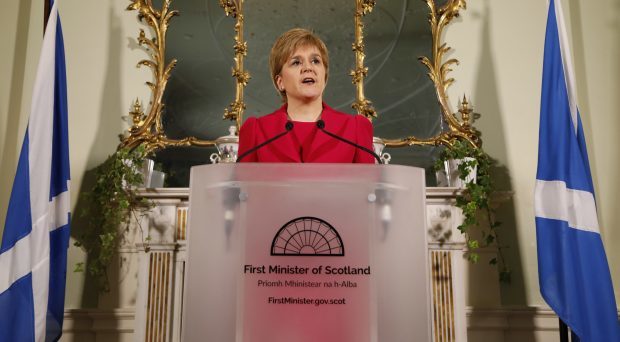Nicola Sturgeon has announced that she will seek authority from the Scottish Parliament to trigger a second referendum on Scottish independence.
The First Minister, speaking at Bute House this morning, said she would look to gain such permissions as early as next week, with a vote most likely taking place between autumn 2018 and spring 2019.
Ms Sturgeon said her focus throughout negotiations had been on “trying to find an agreement with the UK Government” but could not pretend that any compromise was “remotely likely”.
She said that it was not just Scotland’s relationship with Europe that is at stake but “the kind of country we will become”.
“It is now time for me to set out decisively and with clarity the way forward,” she said. “I will now take the steps necessary to ensure that Scotland will have a choice at the end of this process.”
The First Minister added: “The Scottish Government’s mandate for offering this choice is beyond doubt. So next week I will seek the approval of the Scottish Parliament to open discussions with the UK Government on the details of a Section 30 order – the procedure that will enable the Scottish Parliament to legislate for an independence referendum.”
She continued: “If I ruled out a referendum, I would be deciding – completely unilaterally – that Scotland will follow the UK to a hard Brexit come-what-may, no matter how damaging to our economy and our society it turns out to be.
“That should not be the decision of just one politician – not even the First Minister. It will be decided by the people of Scotland. It will be Scotland’s choice.”
Responding to the announcement, Scottish Conservative leader Ruth Davidson said Nicola Sturgeon had “given up acting as First Minister for all of Scotland”.
“People have said time and again they do not want to back to the division of a second referendum,” she said.
She added: “Both No and Yes voters have been urging her to put this to one side – but because of her own rash decision to use Brexit in a bid to lever support for independence, she has ignored them completely.
“Quite simply, today the First Minister has failed in her job to act in the interests of all of us.”
Scottish Labour leader Kezia Dugdale warned that another referendum could risk dividing the people of Scotland.
“Scotland is already divided enough,” she said. “We do not want to be divided again, but that is exactly what another independence referendum would do.
“Two years ago, 85 per cent of Scotland’s voters took part in the independence referendum and the result was a clear vote to remain in the UK.
“With our country facing all of the uncertainty around the Tories’ reckless plans for a hard Brexit, the last thing we need is even more uncertainty and division.”
Scottish Liberal Democrat leader Willie Rennie said: “The SNP have been working towards this announcement for months. They have been determined to contrive a way to ignore their promise that 2014 was ‘once in a generation’.
“There is no wide public support for a new and divisive referendum. Scottish Liberal Democrats stood on a manifesto to oppose a divisive referendum and we will do that.”
A UK Government spokesman said:”Only a little over two years ago people in Scotland voted decisively to remain part of our United Kingdom in a referendum which the Scottish Government defined as a ‘once in a generation’ vote.
“The evidence clearly shows that a majority of people in Scotland do not want a second independence referendum.
“Another referendum would be divisive and cause huge economic uncertainty at the worst possible time.
“The Scottish Government should focus on delivering good government and public services for the people of Scotland.”










